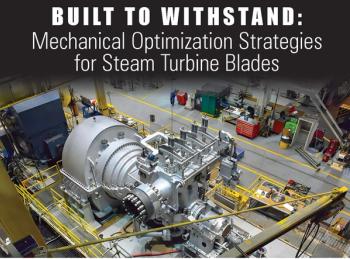
Micro-Gas Turbines: A Challenging Market Yet Promising Technology
At Turbo Expo 2025, ETN Global says micro-gas turbines must focus on specialized markets, cost reduction, and continued technological refinement to remain competitive.
Tuesday afternoon at Turbo Expo 2025, Antonio Escamilla Perejon, Client Relationship Manager, and Giuseppe Tilocca, Technical Lead of ETN Global, presented Micro-Gas Turbines: Technological Advancements and Market Research.
Perejon kicked off the session by introducing the audience to the micro-gas turbine community, how to join, and highlighted two ongoing projects: Next Entity and Fit for Micro.
Before diving into micro-gas turbines, he introduced thermodynamic cycles. “Maximizing thermal efficiency" is key, he said.
- The simple Brayton cycle involves compressing air, combusting fuel, and expanding the heated fluid in a turbine to produce electricity.
- The regenerative Brayton cycle includes a regenerative heat exchanger. The fluid exiting the turbine is used to heat the fluid coming from the compressor. The thermal efficiency of the regenerative cycle is now dependent on both pressure ratio and temperature ratio. Regenerative cycles are more effective than the Brayton cycle at lower pressure ratios.
Complex cycles with two-stage compression and expansion are beneficial to small gas turbines based on the fundamental thermodynamic cycles driving these innovations and the broader landscape of energy innovation. Pressure ratios, meticulous temperature management, and ongoing technological improvements are necessary when creating efficient, compact energy solutions for decentralized power generation.
Perejon said during a recent community meeting, there was inherent complexity and a striking lack of standardized criteria across the industry in terms of micro gas turbine definitions. A key takeaway was the undeniable importance of recuperators in significantly improving electrical efficiency, though limitations often associated with single-stage compressors were also acknowledged.
With micro-gas turbines, there are intricate trade-offs among system size, performance, and cost, and they must be considered when designing and implementing them across diverse power output ranges.
Several advancements have been made through various micro-gas turbine research projects that are pushing the boundaries of sustainable energy technologies, including:
- Seamless solar power system integration
- Innovative applications like using micro-gas turbines as fuel cell replacements for aircraft auxiliary power units
- Harmonizing micro gas turbines with water treatment plants
- Exploring sophisticated hybrid systems with fuel cells
- Rigorously investigating sustainable biofuel applications
Looking ahead, the development drivers are focused on increasing turbine temperature, leveraging advanced materials, achieving significant cost reductions, and exploring novel external fire and hybrid configurations to continuously improve efficiency and performance.
Key Takeaways
- Thermodynamics and Design Hurdles: Key considerations include optimizing thermal efficiency, managing pressure ratios and temperatures, and overcoming limitations like those of single-stage compressors. The role of recuperators in boosting efficiency and the trade-offs between size, performance, and cost were also central.
- Diverse Applications, Lacking Standardization: Despite a lack of standardized definitions for micro gas turbines, the presentations showcased their wide-ranging applications. These include integration with solar power systems and water treatment plants, serving as fuel cell replacements for aircraft, and utilizing sustainable biofuels, underscoring their versatility in decentralized power generation.
- Future-Forward Development: Future advancements hinge on increasing turbine operating temperatures, adopting advanced materials, and cost reduction. The exploration of external fire and hybrid configurations (e.g., with fuel cells) is also crucial for enhancing both efficiency and sustainability in micro gas turbine technology.
A History of the Micro-Gas Turbine Market
Tilocca offered attendees a comprehensive overview of the micro-gas turbine market. Micro-gas turbines became commercially viable in 1998, with companies like Capstone leading early development. The market size is estimated at around 100 million units, although Tilocca said that precise numbers are less important than understanding the market dynamics: "We're wasting time debating exact figures.”
The development of micro-gas turbines is divided into two phases:
- First Wave (early 2000s): Focused on increasing power output and efficiency
- Second Wave (2010s): Attempting to reduce costs and improve commercial viability
The market has faced significant obstacles, with multiple companies experiencing bankruptcy due to several key challenges:
Limited Applications: Microgas turbines are mainly used in primary generation and co-generation in niche markets—such as oil and gas, decentralized power, biogas and sewage gas applications, and cogeneration—due to cost and performance.
Efficiency Concerns: When compared to reciprocating engines, micro-gas turbines struggle with performance. Tilocca explained: “Micro-gas turbines have no edge on the heat-to-power ratio. You cannot compete in the cogeneration applications with a high heat-to-power ratio, and the cost needs to be lower; otherwise, you won't sell any products because you're directly competing with reciprocating energy. The cost of a gas turbine versus the cost of a reciprocating engine is very expensive.”
Micro-gas turbine technology suffers from competition from internal combustion engines, advancing fuel cell technologies, and growing electrification trends.
But, despite challenges, micro-gas turbines offer some unique benefits:
- Low maintenance requirements
- Single exhaust stream that’s ideal for hybrid heat applications
- Low NOx emissions (below 15 ppm)
- Excellent performance with renewable and difficult fuels
"Micro-gas turbines are a niche product. If you try to market them as a mass product, you will not succeed,” Tilocca said.
Looking forward, considerations such as equipment cost reductions, improved overall efficiency, scaled-up production, and targeted niche applications are critical. When exploring hydrogen applications, it’s important to balance efficiency and cost. He said that equipment costs become increasingly critical as hydrogen fuel prices decrease.
“Micro-gas turbines have low market assessment," Tilocca said, with promising opportunities in renewable fuel and biogas and decentralized power applications.
Key Takeaways
- The development of micro-gas turbines has occurred in two distinct phases: the first focused on increasing power output, while the second concentrated on improving efficiency and reducing costs. However, most commercially available products were developed over 20 years ago, with minimal technological advancement.
- Micro-gas turbines remain a niche market with limited growth, characterized by high costs, low efficiency, and challenges in scaling production. Despite potential applications in specific sectors like oil and gas and renewable fuels, the technology struggles to compete with reciprocating engines and other power generation technologies.
- The economic viability of micro-gas turbines heavily depends on fuel costs, operational hours, and specific application requirements. They show promise in scenarios with high heat-to-power ratio needs, remote locations, or when working with challenging fuels like biogas, but face significant challenges in becoming a mainstream power generation technology.
Newsletter
Power your knowledge with the latest in turbine technology, engineering advances, and energy solutions—subscribe to Turbomachinery International today.





